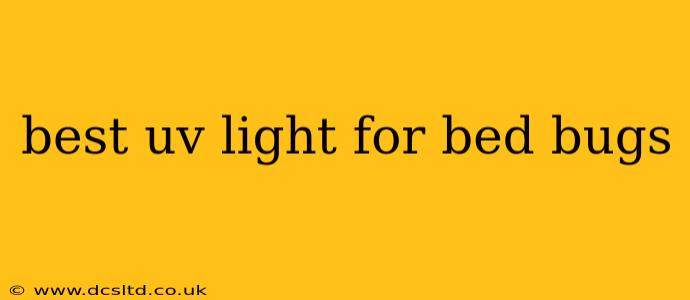Bed bugs are tiny, nocturnal insects that feed on human blood, causing itchy bites and sleepless nights. While various methods exist for bed bug control, ultraviolet (UV) light is often touted as a potential solution. This guide explores the effectiveness of UV lights for bed bug detection and eradication, helping you understand if this method is right for your situation. We'll also address frequently asked questions surrounding UV light and bed bug control.
Does UV Light Kill Bed Bugs?
The short answer is: UV light alone is not an effective method for killing bed bugs. While UV-C light, a specific type of ultraviolet light, can kill certain microorganisms, its effectiveness against bed bugs is limited. Studies have shown that UV-C light needs prolonged exposure at close range to kill bed bugs, and even then, it's not guaranteed. Furthermore, it’s challenging to expose all bed bugs within an infestation to sufficient UV-C light due to their hiding habits. This makes UV light more useful as a detection tool than an eradication tool.
Can UV Light Help Detect Bed Bugs?
Yes, UV light can aid in bed bug detection, but not directly. The UV light itself doesn't make the bed bugs glow. Instead, some UV flashlights are designed with a black light feature, capable of revealing bed bug excrement (feces) and stains. These stains, often appearing dark brown or reddish, are more easily visible under UV light, indicating the presence of bed bugs. This is especially helpful in locating infestations in hard-to-reach areas. However, the absence of visible stains doesn't guarantee the absence of bed bugs.
What Type of UV Light is Best for Bed Bug Detection?
The best type of UV light for bed bug detection is a UV-A black light. These lights emit long-wave ultraviolet light, making the bed bug stains easier to spot. While UV-C lights are more powerful at killing germs, they aren’t as effective for this purpose and can be dangerous if misused.
Are There Any Other Ways to Detect Bed Bugs?
While a UV black light can help, it shouldn't be your only detection method. Other detection techniques include:
- Visual inspection: Carefully examine your mattress, box spring, bed frame, and surrounding areas for live bed bugs, eggs, or shed skins.
- Interception traps: Place sticky traps under your bed legs to catch bed bugs moving around.
- Professional inspection: A pest control professional has the expertise and tools to thoroughly inspect your home and identify infestations effectively.
How Effective Are UV Lights Compared to Other Bed Bug Treatments?
UV lights are not a primary treatment for bed bugs. Other more effective methods include:
- Heat treatment: This method uses high temperatures to kill bed bugs and their eggs.
- Chemical treatments: Professional pest control companies utilize insecticides specifically designed for bed bug eradication.
- Steam cleaning: Steam can effectively kill bed bugs and their eggs on surfaces.
What are the Safety Precautions When Using UV Lights?
- Eye protection: Always wear UV protective eyewear when using UV lights, as prolonged exposure can damage your eyes.
- Skin protection: Direct exposure to UV light can cause sunburn. Limit your exposure time and use protective clothing if necessary.
- Proper disposal: Follow the manufacturer's instructions for the proper disposal of used UV bulbs.
Conclusion: UV Light and Bed Bugs
UV light, particularly UV-A black lights, can be a helpful tool for detecting bed bugs by highlighting their fecal stains. However, it is not an effective method for eliminating them. For effective bed bug control, a combination of thorough detection methods (including a UV black light) and professional pest control treatment is usually necessary. Never rely solely on UV light to get rid of a bed bug infestation.
